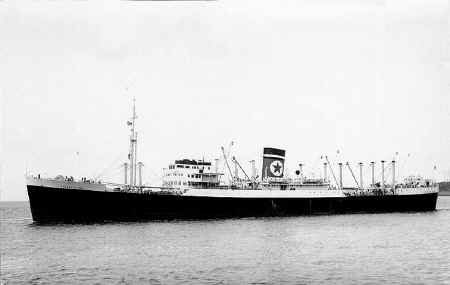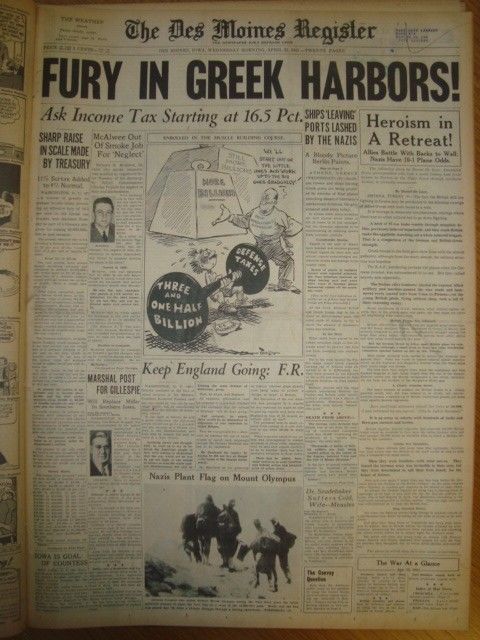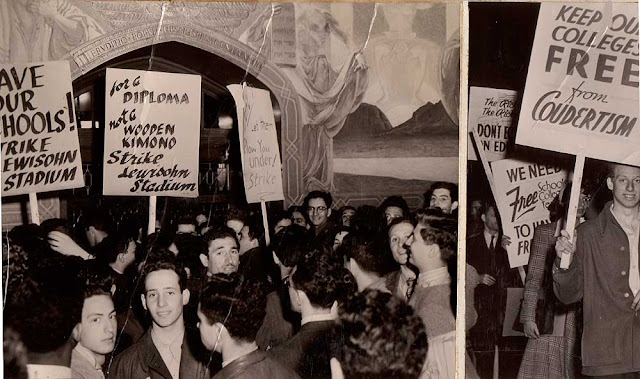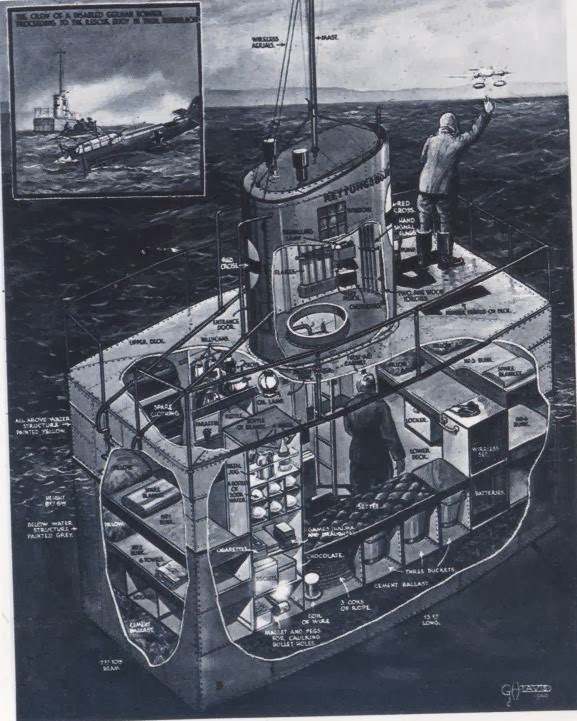Thursday 24 July 1941
 |
| Russian POWs loaded onto trucks to be taken to their final destination. Zhytomyr Lager, Ukraine, 24 July 1941. |
On the other side of Lake Ladoga, Finnish VII Corps continues forcing its way forward against heavy Soviet resistance. It approaches the town of Sortavala on the road that runs along the fringes of Lake Ladoga. The Finns capture Vidlitsa and Rajakonru northeast of Lake Ladoga. Further north, Finnish 14th Infantry Division (Colonel Erkki Raappana) takes Omelia, wiping out Soviet 337th Rifle Regiment.
In the Army Group North sector, the Wehrmacht consolidates its position as it prepares for the final advance on Leningrad.
In the Army Group Center sector, Soviet troops attack the exposed Panzer Group 2 bridgehead at Yelnya. At Velikiye Luki, Soviet counterattacks cut German lines of communication and the Wehrmacht retreats in the area. The Germans are under heavy pressure in this sector and have to throw service troops into the line.
In the Army Group South sector, Romanian Third and Fourth Armies in conjunction with the German 11th Army complete the occupation of Bessarabia, Northern Bukovina, and Hertsa. These are territories ceded by Romania to the Soviet Union in 1940. This completes Operation München. Romania intends to reincorporate the region into the Romanian State.
The Luftwaffe, after a night off, again attacks Moscow. Tonight, the number of bombers is reduced to 100. Red Army night fighter pilot Kapitan Konstantin Titenkov claims a bomber for his third success in three nights.
RAF Bomber Command also sends a diversionary raid of 36 Blenheims against Cherbourg. The raid causes some damage to the docks but does not attract any defending fighters away from Brest as desired. So far so good for the Germans - but there is more to come.
A third raid targets La Pallice, where heavy cruiser Scharnhorst arrived on the 23rd. This is an additional 200 miles further south, so there are no escorting RAF fighters. The attack by 15 Halifaxes of RAF No. 35 and 76 Squadrons are pressed home with great courage against heavy Luftwaffe opposition and score five hits. Three bombs pass straight through the ship, and two other bombs explode and cause only light damage. However, the Germans are forced to concede that the move to La Pallice was a mistake, so, despite the ship taking on water, they send Scharnhorst back to Brest after dark. Scharnhorst is out of action until November, at a cost to the RAF of five Halifax bombers and damage to the rest.
After dark, RAF Bomber Command sends 34 Wellingtons (one lost) and 30 Hampdens (one lost) against Kiel. As has been the case often recently, accuracy is poor, and the only deaths are five people in the nearby village of Wellsee, Germany, which is near Kiel. Another raid by 31 Whitleys and 16 Wellingtons against Emden results in the loss of two Wellingtons. The RAF also sends 4 Wellingtons over Rotterdam and six on minelaying missions in the Frisian Islands, both without loss.
During the raid on La Pallice, the German defenders accidentally down a returning Focke-Wulf FW-200 returning from an Atlantic reconnaissance flight.
 |
| RAF Pilot/Officer Joseph Francis Patrick John McKenna, KIA 24 July 1941 at Nantes, France. He is buried at the War Cemetery in Loire-Atlantique, about fifty kilometers from Nantes in France. |
Major Günther Freiherr von Maltzahn, Kommodore of JG 53 and a 42-victory ace, is awarded the Eichenlaub.
The weekly RAF operations report shows that for the week ending 23 July:
- Coastal Command flew 252 patrols and 364 sorties
- RAF Fighter Command flew 704 ship protection patrols.
 |
| Australian troops with captured Morane-Saulnier MS.406C1 fighters of Groupe de Chasse I/7, Aleppo-Nerab, Syria, 24 July 1941. (Australian War Memorial 008990). |
The RAF (No. 42 Squadron) sinks 370-ton Norwegian freighter Vestkyst I off Skadberg, Norway.
German destroyer Hermann Schoemann, operating off of Kharlov Islands, uses gunfire to sink 540-ton Soviet whaler Meridian.
U-652, operating off the Russian Kildin inlet in the far north, attacks Russian patrol boat SKR-23 "Musson" but misses.
German scouts spot Allied convoys OG-69 and SL-80 at sea and U-boat Command (BdU) direct U-boats toward them.
US Aircraft carrier USS Wasp loads 30 P-40s and three Stearman PT-13 Kaydet trainers at Norfolk for transport to Iceland.
Convoy OS-1 departs from Liverpool bound for Freetown, Convoy SL-82 departs from Freetown bound for Liverpool. Convoys SL-79 and HG-67 both arrive in Liverpool.
U-454 and U-580 are commissioned.
 |
| MV Sydney Star which was damaged on 24 July 1941. |
Italian torpedo boat MAS-533 torpedoes and damages 11,219-ton freighter Sydney Star. Destroyer Nestor tows the Sydney Star to Malta, where the freighter is put in drydock for repairs.
Italian bombers based in Sardinia damage 9351-ton British tanker Hoegh Hood, part of Convoy MG-1 returning to Gibraltar from Malta. The Hoegh Hood, which is empty, is able to continue to Gibraltar.
An Italian CANT Z.506 reconnaissance seaplane, escorted by 42 Macchi C.200 fighters, spots the Operation Substance ships arriving in Malta. The RAF launches 22 Hawker Hurricanes to attack the Italian formation, and the British shoot down three of the Italian fighters without loss to themselves. Overall, the Italians lose about a dozen aircraft during their operations surrounding Operation Substance.
Royal Navy submarine HMS Upholder torpedoes and damages 4964-ton Italian freighter Dandolo off the west coast of Sicily.
Royal Navy submarine HMS Upright, operating off Cape dell Armi, uses its deck gun to attack floating dock G022. The Italians immediately send ships out to launch depth charge attacks, but Upright gets away.
Italian submarine Squalo claims to damage a British tanker northeast of Tobruk, but there is no confirmation or identification of what ship it is.
Operation Guillotine, the reinforcement of Cyprus, continues. Royal Navy transport Gujarat, escorted by Australian sloop HMAS Parramatta, travels from Port Said to Famagusta without incident.
 |
| Italian soldier executing civilians in Sinj, Croatia, 24 July 1941. |
POWs: A group of Dutch troops, 68 officers, arrives at Colditz Castle, an Oflag IV-C camp. They are the first Dutch prisoners.
German/Italian Relations: Mussolini offers to add another Italian army corps to the one already allocated to the eastern front.
US/German/Italian Relations: US troopship USS West Point (AP-23) arrives in Lisbon. It carries German and Italian consular personnel and their families who have been ordered to return to Europe by the United States government.
 |
| Two USAAF B-18 bombers in the Philippines, 24 July 1941. |
After the meeting, Acting Secretary of State Sumner Welles issues a statement regarding the Japanese/Vichy French agreement regarding Japanese use of French Indochina. It notes in part:
By the course which it has followed and is following in regard to Indochina, the Japanese Government is giving clear indication that it is determined to pursue an objective of expansion by force or threat of force.The statement does not, however, indicate that the United States will take any direct action as a result of the Japanese establishment of military bases in the territory.
Anglo/Free French Relations: Charles de Gaulle remains extremely upset about having Free French forces not included in the treaty ending the conflict in the Levant. At his demand, Free French forces revert to his command from British control at noon.
 |
| Japanese troops enter Saigon by bicycle, 24 July 1941. (Japanese army photo). |
German Military: General der Panzertruppe Walther Kurt Josef Nehring is awarded the Knight's Cross. He is Generalmajor and commander of the 18th Panzer-Division.
US Military: The US Marine Corps establishes a detachment of the 1st Defense Battalion at Johnston Island southwest of Hawaii in the Pacific.
 |
| Fw 200 C-2 W.Nr. 0026 "F8+CH", 1./KG 40, Bordeaux, before 24 July 1941, the date when it was shot down with all its crew near Ireland. |
The German army is technically the most perfect in the world; and the German soldier, in a moment of crisis, is safer and sounder than any other soldier. I'm truly happy that it has been granted to me to see, in my lifetime, the German soldier rewarded by Providence. For an elite force, like our SS, it's great luck to have suffered comparatively heavy losses. In this way, it's assured of the necessary prestige to intervene, if need be, on the home front — which, of course, won't be necessary. But it's good to know that one disposes of a force that could show itself capable of doing so, on occasion.Ordinary soldiers may not agree that their losses are worth it for the prestige granted their formations. There is no question, however, that the SS is loaded with fanatical troops who might, in fact, agree with Hitler.
 |
| One of two checkpoints at the Kishinev Ghetto circa 1941. |
A local SS commander reports to headquarters that 4435 Jews have been exterminated at Lachowicz.
German SS troops execute Jewish citizens of Grodz, Lithuania.
Canadian Homefront: About 700 workers in Arvida, Quebec begin an illegal strike against their employer, the Alcan aluminum company. Alcan is considered essential to the war effort, and thus the strike is illegal.
American Homefront: The New York Times publishes a quote from Senator Harry Truman of Missouri regarding the German invasion of the Soviet Union: "If we see that Germany is winning we ought to help Russia, and if Russia is winning we ought to help Germany, and in that way let them kill as many as possible."
 |
| Motor launch for hospital ship MS Oranje, Cockatoo Island, 24 July 1941. |
July 1941
July 1, 1941: US TV Broadcasting Starts
July 2, 1941: MAUD Report
July 3, 1941: Stalin Speaks
July 4, 1941: Pogroms in Eastern Europe
July 5, 1941: Germans on Schedule
July 6, 1941: Australians Attack Damour
July 7, 1941: US Marines in Iceland
July 8, 1941: Flying Fortresses In Action
July 9, 1941: British Take Damour
July 10, 1941: Sword and Scabbard Order
July 11, 1941: Cease-fire in Syria and Lebanon
July 12, 1941: Anglo/Russian Assistance Pact
July 13, 1941: Uprising in Montenegro
July 14, 1941: Katyusha Rocket Launchers in Action
July 15, 1941: Smolensk Falls
July 16, 1941: Stalin's Son Captured
July 17, 1941: Heydrich Orders Mass Executions
July 18, 1941: Twin Pimples Raid
July 19, 1941: V for Victory
July 20, 1941: The Man Who Wouldn't Shoot
July 21, 1941: Moscow in Flames
July 22, 1941: Soviet Generals Executed
July 23, 1941: Secret Plan JB 355
July 24, 1941: Operation Sunrise
July 25, 1941: US Naval Alert
July 26, 1941: Italian E-Boat Attack on Malta
July 27, 1941: MacArthur Returns
July 28, 1941: Auschwitz Exterminations
July 29, 1941: Rescue From Crete
July 30, 1941: Raid on Petsamo and Kirkenes
July 31, 1941: Final Solution Order
2020
















